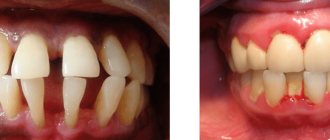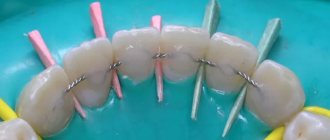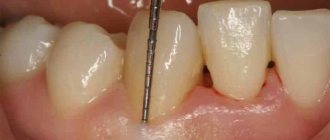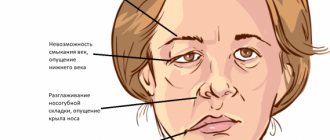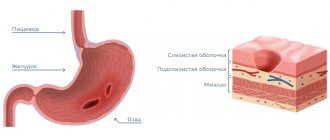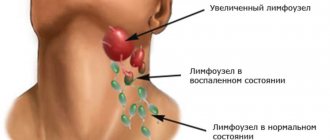About lymph
The lymphatic system consists of lymph nodes and the vessels that feed them. It is multifunctional, but its main function is to protect the body from various pathogens.
For this purpose, immune cells exist in the lymph nodes - T-lymphocytes and B-lymphocytes.
The passage of blood through small capillaries creates a plasma filtration effect. Some of the blood enters the surrounding tissues, and some goes back into the bloodstream. Another one - into the vessels. The result is the formation of lymph. It is a clear, watery liquid containing immune cells.
Lymphatic vessels, uniting, enter the thoracic lymphatic ducts, right and left, the same, in turn, flow into the veins. This results in the return of fluid to the bloodstream.
Lymph nodes, as part of the body's immune system, are located in different parts of the body. Their task is to be filters, a kind of barriers for infectious carriers and pathogenic cells.
Localization of lymph nodes in the neck
Lymph nodes are located throughout the body. Now we are interested in the neck, where there are such groups of lymph nodes:
- Chin;
- Submandibular;
- Preglottic;
- Jugular;
- Parotid;
- BTE;
- Occipital;
- Posterior cervical;
- Supraclavicular.
Bone biopsy
A medical examination involves feeling them. An enlarged lymph node means certain pathological processes occurring in it. This can be an inflammatory, purulent process, the occurrence of infection, as well as oncology.
Inflammation of the lymph nodes in the neck: causes
As we said above, different causes of lymphadenitis prevail at different ages. In children under 5 years of age, the main role is played by acute respiratory viral infections (influenza, pneumonia, tonsillitis, otitis, rhinitis), as well as foci of chronic infection in the tonsils, inner and middle ears. Less commonly, the development of lymphadenitis at this age is associated with pustular lesions of the skin of the face and head, as well as with inflammation of the oral mucosa due to stomatitis or as a result of traumatic damage. The development of lymphadenitis can also be triggered by the BCG vaccine against tuberculosis.
Diagnosis and treatment of all of the above non-odontogenic lymphadenitis (i.e., not associated with teeth) is most often carried out by pediatricians and infectious disease specialists. But as for the age from 6 to 12 years, up to 70% of cases of inflammation of the lymph nodes in a child are associated with foci of purulent inflammation in the area of the roots of the teeth. Lymphadenitis, the cause of which is inflammation of the teeth, is called “odontogenic”. And therefore, the first doctor you should contact in order to find the source of the infection should be a dental surgeon.
Causes of odontogenic lymphadenitis in children and adults –
- acute purulent periodontitis (or exacerbation of chronic periodontitis),
- suppuration of a cyst at the apex of the tooth root,
- difficult teething (including the lower wisdom tooth),
- alveolitis (inflammation of the socket of an extracted tooth),
- purulent periostitis (flux),
- osteomyelitis of the jaws,
- perimaxillary abscesses and phlegmons,
- odontogenic sinusitis,
- stomatitis of the oral mucosa.
Differences between odontogenic and non-odontogenic lymphadenitis –
As for odontogenic lymphadenitis, most often complaints are made about unilateral inflammation of the lymph nodes in the neck, which corresponds to the submandibular group of lymph nodes (submandibular lymphadenitis). If you start questioning the patient, you can often find that inflammation of the lymph node was preceded by pain in one of the teeth, or gumboil may have formed on the gum before this, or one of the teeth was recently treated by a dentist. Those. usually there is always an exact connection between inflammation of the lymph node and the causative tooth (on the same side), or with a disease of the oral mucosa.
In acute nonodontogenic lymphadenitis, patients complain of the appearance of not one, but usually several “balls” at once in the submandibular region or upper parts of the neck. Moreover, patients clearly associate this with a recent sore throat, otitis media or acute respiratory viral infection. A feature of non-odontogenic lymphadenitis is that inflammation of the lymph nodes occurs in several anatomical areas at once, often symmetrical (by the way, this is one of the distinctive signs of non-odontogenic lymphadenitis). In addition, non-odontogenic lymphadenitis is always accompanied by a general inflammatory process in the body associated with the underlying disease, for example, otitis media or tonsillitis.
Which lymph nodes are most likely to become inflamed?
Moreover, it is approximately always possible to determine the source of inflammation of a lymph node if you know the paths of lymph outflow from various areas of the face - to the lymph nodes of a certain location. Most often in children and adults, inflammation of the submandibular lymph nodes located along the lower edge of the lower jaw occurs. Lymph flows into the submandibular nodes from the bone tissue, periosteum and teeth of the lower jaw (from the canine to the third molar), as well as from the tonsils, skin of the external nose and the anterior mucous membrane of the nasal cavity.
In addition, lymph partially enters the submandibular lymph nodes from bone tissue, periosteum and teeth of the upper jaw (from the fourth premolar to the third molar). An important point is that slightly deeper than the submandibular lymph nodes there are retropharyngeal lymph nodes, to which lymph flows from the middle ear, from the posterior parts of the nasal cavity, and also partially from the tonsils, and from the hard and soft palate.
Another important group is the mental lymph nodes, into which lymph flows from the skin of the upper and lower lips, from the roots of the lower incisors and canines, from the bone and periosteum of the mental region of the lower jaw. Accordingly, inflammation of this group by the lymph node can be caused, for example, by a focus of purulent inflammation in one of the lower front teeth. But lymph flows to the parotid lymph nodes from the skin of the forehead, ears, external auditory canals, cheeks and upper lip. Accordingly, inflammation of the parotid lymph nodes can be triggered by an inflammatory process in these tissues.
Indications
There are many indications for the procedure:
- Node over 1 cm;
- Soreness;
- Inflammatory process for no apparent reason;
- Suspicion of a malignant tumor;
- The lymph node does not change, although treatment has been carried out for a long time;
- Sarcoidosis or lymphogranulomatosis, etc.
This procedure provides an understanding of:
- What is the specificity of the course of the disease;
- What is the level of infection;
- If a patient with cancer has metastases.
Causes of inflammation of the lymph nodes in the neck
Below we will talk about the main reasons for the onset of the inflammatory process of the lymph node in the neck:
- The entry of viruses or harmful organisms into the body manifests itself in chickenpox, mononucleosis, herpes, rubella;
- Diseases of the nasopharynx (sinusitis), oral cavity (caries, gingivitis, stomatitis, etc.);
- Reduced immunity;
- Mechanical trauma or impact on the lymph node;
- Hypothermia is especially dangerous in the demi-season;
- Vitamin deficiency, lack of nutrients;
- Allergic reaction;
- Increased stress, fatigue;
- Venereal diseases.
Teething in children is often the cause of enlarged lymph nodes in the neck. Also, this pathology occurs in pregnant women. A constant deficiency of vitamins and nutrients in the body can cause chronic inflammation of the lymph nodes not only in the neck, but also in other parts of the body.
Oncology and enlarged cervical lymph nodes
Some cancers (lymphomas) arise and develop in the lymph nodes. They are classified as:
- Hodgkin's lymphoma;
- Non-Hodgkin's lymphomas.
But more often metastases penetrate the lymph nodes.
This occurs due to the ability of cancerous tumors to metastasize. Benign tumors do not have this ability.
Breaking away from the lesion, the mutated cells migrate, enter the blood and lymphatic vessels and create secondary lesions. The lymph nodes adjacent to the primary lesion become the most vulnerable.
Metastasis to cervical lymph nodes
Cervical lymph nodes are at greater risk of metastasis. It is there that metastases of squamous cell carcinoma of the upper respiratory tract, cancer of the thyroid gland, skin and salivary glands penetrate.
Sometimes the primary lesion is localized in another part of the body:
- Breast cancer – up to 4.5% of cases;
- Lung cancer – up to 32% of cases;
- Oncology of the esophagus – up to 30% of cases;
- Kidney cancer – up to 8% of cases;
- Testicular cancer – up to 4.5%.
Minor rates of metastasis were diagnosed in oncology of the cervix, uterine body, prostate, central nervous system, liver, bladder, and ovaries.
Lymph nodes of the neck
The current classification of the American Joint Committee on the Study of Malignant Tumors and the American Academy of Otorhinolaryngology and Head and Neck Surgery was modified by K. Robbins et al. in 2000 and approved by the AJCC-AAOHNS in 2001. It proposed dividing the 3 levels into sublevels. The classification of lymph nodes by level is known all over the world, is convenient to use, easy to remember and, most importantly, allows specialists to speak the same language. It has already become the basis for the classification of cervical dissections.
Using the classification of neck lymph nodes by level will help solve a number of problems that arise, in particular: 1) when determining the scope of surgical intervention and planning radiation therapy; 2) when a patient who was treated in one medical institution goes to another with an extract indicating that the patient underwent fascial-sheath excision of the tissue of the neck and the exact volume of intervention is not indicated. In the first situation, where, according to the ultrasound, there is a lesion in the cervical-supraclavicular zone without indicating the levels, it is difficult for us to assess the volume of the lesion. In the second situation, without a surgical protocol, it is impossible to know the exact extent of the previously performed operation.
Classification
I (IA and IB)
– below the body of the lower jaw (behind the branch of the lower jaw - this is already IIA);
IA - group of mental nodes
IB is a group of submandibular lymph nodes (located in front and behind the submandibular salivary gland). If the lymph nodes of this level or the gland itself are affected, it is removed.
II, III, IV – jugular
– along the neurovascular bundle (internal jugular vein) covered by m.sternoclaidomastoideus
II - upper jugular - from the level of the base of the skull to the level of the lower edge of the hyoid bone IIA - upper anterior jugular - anterior to the posterior edge of the internal jugular vein; IIB - superior jugular posterior - posterior to the posterior edge of the internal jugular vein.
III - middle jugular - from the level of the lower edge of the hyoid bone to the level of the lower edge of the cricoid cartilage of the larynx;
IV – lower jugular – from the level of the lower edge of the cricoid cartilage of the larynx to the clavicles (including Virchow’s);
V – posterior (lateral) triangle of the neck
corresponds to anatomical boundaries
VA – accessory – above the level of the lower edge of the cricoid cartilage, along the anterior surface of the trapezius muscle, VB – supraclavicular – below the level of the lower edge of the cricoid cartilage (excluding Virchow’s);
VI - anterior neck space - pre- and paratracheal lymph nodes, preglottic (Delphian) and parathyroid lymph nodes
, including lymph nodes along the recurrent laryngeal nerve)
Table
Groups of lymph nodes not included in the classification.
When describing all the groups of lymph nodes listed below, it is necessary to use traditional names.
1. Lymph nodes of the postauricular area.
2. Suboccipital lymph nodes.
3. Parotid lymph nodes (inside and extraparotid salivary gland).
4. Lateral and medial retropharyngeal lymph nodes (their defeat is important for cancer of the nasopharynx and oropharynx).
5. Facial lymph nodes.
6. Upper mediastinal lymph nodes (not related to the lymph nodes of the neck).
Examples of lymphadenopathy of different groups of lymph nodes in the neck.
The CT image below shows necrosis of group IA lymph nodes.
The CT image below shows group IB lymphadenopathy on the right.
The post-contrast CT image shown below shows a patient with tongue carcinoma and lymphadenopathy of group II lymph nodes.
The post-contrast CT image below shows enlargement and contrast enhancement of group III lymph nodes.
On the post-contrast image, the white arrow indicates an enlarged group IV lymph node. The patient had the right lobe of the thyroid gland and the right jugular vein removed, as indicated by the black arrow, due to papillary carcinoma.
On the post-contrast image, the white arrow indicates an enlarged group V lymph node.
On the post-contrast image, the white arrow indicates an enlarged group VI lymph node.
Source
- Cervical lymphadenopathy: what radiologists need to know Vincent Chong Department of Diagnostic Radiology, Singapore General Hospital, Singapore Corresponding address: Vincent Chong, Department of Diagnostic Radiology, Singapore General Hospital, Outram Road, Singapore 169608. Date accepted for publication 19 January 2004
- S. Subramanian1,2, V.L. Lyubaev1, V.Zh. Brzhezovsky1, A.A. Aidarbekova1 CLASSIFICATION OF LYMPH NODES OF THE NECK: THE NEED FOR TRANSITION TO MODERN CLASSIFICATION IN ONCOLOGICAL PRACTICE 1 Research Institute of Clinical Oncology, State Russian Cancer Research Center named after. N. N. Blokhina RAMS, Moscow 2 Department of Oncology, Moscow Medical Academy named after. I. M. Sechenova, Moscow
- CT diagnostics of malignant tumors of the oral cavity, pharynx, larynx. Kuraeva Lyudmila MDC-Dimitrov, Koritko Yuri MC Tomograd.
- Radiology Assistant
- Radiomed
How to detect metastases in lymph nodes
The problem is not simple, since if there are a small number of mutated cells in the lymph nodes, there are usually no symptoms. If there is any suspicion, the doctor must make an accurate diagnosis.
This is where lymph node biopsy comes to the rescue. It is carried out in different ways:
- Biopsy with needle insertion into a questionable node. Carry out under local anesthesia. The procedure takes up to 30 minutes.
- Open biopsy. This is a surgical procedure performed under anesthesia, local or general, with the removal of part or all of the lymph node.
- Sentinel lymph node biopsy. A radiopharmaceutical or fluorescent dye is injected into the tumor. Penetrating the lymph vessels, it reveals the problem node, the so-called sentinel node.
After the biopsy procedure, all materials are sent to the laboratory for study.
Consequences
In general, patients easily tolerate the procedure; there are no consequences or complications. But you still have to deal with symptoms that arise as consequences of the procedure. It can be:
- Feeling weak;
- Temperature increase;
- Painful sensations in the head and neck area;
- Dizziness;
- Nerve pinching or damage
Unpleasant consequences can be caused by insufficient qualifications of the doctor - damage to the vessel, penetration of bacteria.
If you experience the above symptoms, you should consult a doctor. At the Onco.Rehab oncology clinic, you can get the addresses of our reliable partners, where lymph node biopsies are performed in accordance with international standards.
Lymphadenitis: treatment
In the treatment of lymphadenitis, the main thing is to eliminate the cause of its occurrence.
Accordingly, in case of odontogenic lymphadenitis, depending on the condition of the tooth and the age of the child, it is necessary to treat or remove the causative tooth. If in adults it is desirable to preserve a tooth in all possible cases, then in children the situation is much more complicated. In children, inflammation at the root apex is treated only in permanent teeth; baby teeth must be removed. This is due to the wide root canals of baby teeth, the immaturity of the apexes of the roots of baby teeth, on which huge apical foramina gape. Such teeth cannot be properly filled, plus there is too great a risk of injury to the permanent tooth germ. Numerous attempts to treat such teeth end in almost 100% of cases with complications - the development of purulent periostitis, inflammation and loss of the permanent tooth germ, sometimes with sepsis and even death. And this is not to mention the fact that the long-term presence of a focus of purulent inflammation in a child affects the entire body, suppresses its immunity, contributing to the occurrence of frequent infectious diseases, allergic reactions, bronchial asthma and other pathologies. This is worth remembering when a not very competent doctor suggests not removing such a tooth, citing possible problems with the bite in the future.
Accordingly, if it is possible to save a permanent tooth in a child or an adult, the tooth is opened (removal of carious tissue, old filling or crown, revision of the root canals) to create an outflow of pus through the root canal. Next, general therapy is prescribed, and after the cessation of suppuration, the inflammatory focus at the apex of the tooth root is treated in the standard way, as for chronic periodontitis, i.e. with placing a special medicinal paste into the root canals. All these actions will prevent further transmission of infection from the source of inflammation - to the lymph nodes.
1) Treatment of serous lymphadenitis -
The treatment tactics for serous lymphadenitis will depend on what day after the onset of the disease the patient went to the doctor (the earlier, the greater the chance of success of conservative treatment). In this case, conservative treatment is first used - compresses with a 5% solution of dimexide, in which anti-inflammatory medications are dissolved. To do this, add 1 ml of hydrocortisone solution, 50% analgin solution and 1% diphenhydramine solution to 10 ml of a 5% dimexide solution.
Drug Dimexide (99% concentrate) –
Next, apply a classic compress to the area where the affected lymph node is located. A gauze cloth is generously moistened with the solution, and a plastic film is placed on top of it (to isolate the solution from air). Under no circumstances should you make a thermal compress by placing any material or towel over the film. Thermal procedures, if this is not 1-2 days of development of the disease, will only aggravate congestion in the lymph node and will contribute to the development of pathogenic microorganisms, i.e. the transition of serous inflammation to purulent (for the same reason, you should not do UHF, bandages with Vishnevsky ointment).
If a child or adult consults a doctor in the first 2-3 days from the onset of the disease, the most effective is the use of physiotherapy methods - phonophoresis of hydrocortisone, electrophoresis of dimexide with an antibiotic and diphenhydramine, laser therapy.
2) Treatment of purulent forms of lymphadenitis -
Surgery is used to treat acute purulent lymphadenitis, exacerbation of chronic purulent lymphadenitis, adenophlegmon. The operation is performed in a hospital setting under general anesthesia, and it is necessary to scrape the necrotic tissue of the lymph node from the wound. In case of chronic hyperplastic lymphadenitis, it is better to remove the lymph node followed by histological examination (moreover, if there is a fistulous tract with granulations growing to the surface of the skin, the lymph node is removed along with the fistulous tract).
After opening the abscess, physiotherapy is prescribed - enzyme electrophoresis, UHF, magnetic therapy, helium-neon irradiation, ultraviolet radiation. Depending on the severity of inflammation, intoxication and the state of immunity, various medications are used. First of all, these are detoxification and antihistamines, sometimes antibiotics. For inflammation of the lymph nodes, not just any antibiotics are used, but those that tend to accumulate in the lymph nodes, for example, the combination of ampicillin + sulbactam, cefazolin, claforan).
Removal of a lymph node for hyperplastic lymphadenitis –
